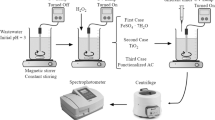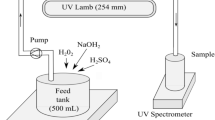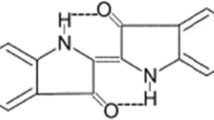Abstract
The remediation of textile dying wastewater was carried out at ambient temperatures in a pilot-scale continuous stirred tank reactor by using the photo-Fenton oxidation process. The preliminary results suggest that the treatment system reached a steady state condition within 5–10 min after it was started up. By using a 2k factorial design, the effects of various parameters on the removal efficiency of color, BOD and COD were identified under steady state conditions. The removal efficiencies of color and BOD were affected by the feed rate of H2O2 and Fe2+, whereas none of the parameters in the investigated ranges affected the removal efficiency of COD. Consequently, using univariate analysis to investigate higher parameter range values, the optimum conditions for treating textile wastewater were found to be 25 ml H2O2/min, 5 ml Fe2+/min and 90 W UV-A power for 20 min. In addition, the removal of all pollutants was enhanced within the acidic pH range. Approximately 69.2, 99.4 and 48.5% of color, BOD and COD were removed, respectively. However, the concentration of TDS increased slightly during the treatment period due to the formation of new species or intermediate oxidation products. Nevertheless, all values of pollutants in the treated wastewater except COD were in the range of the standard values permitted for discharge into the environment.
Similar content being viewed by others
References
DPPEA Water Efficiency Industry Specific Processes, www.p2pays.org/ref/04/03098.pdf. (1996).
J. Sójka-L, T. Koprowski, W. Machnowski and H. H. Knudsen, Desalination, 119, 1 (1998).
I.D. Desai and I. S. Bhardwaj, Recent biotechnological trends in industrial effluent treatment, Biotech Consortium Indai Ltd., New Delhi (1995).
I.M. Banat, P. Nigam, D. Singh and R. Marchant, Bioresource Technol., 58, 217 (1996).
S. S. Shah, J. D. Desai, C. Ramakrishna and N.M. Bhatt, J. Ferment. Bioeng., 86, 215 (1998).
P. C. Venceslau, S. Tom and J. J. Simon, Environ. Technol., 15, 917 (1994).
P. C. Vendevivere, R. Bianchi and W. Verstraete, J. Chem. Technol., 72, 289 (1998).
H. Barlas and T. Akgun, Fresenius Environ. Bul., 9, 597 (2000).
M. S. E. Abdo and R. S. Al-Ameeri, J. Environ. Sci. Health A., 22, 27 (1987).
L. Naumczyk, L. Szpyrkowicz and F. Zilio-Grandi, Water Sci. Technol., 34, 216 (1996).
A.G. Vlyssides and C. J. Israilides, J. Environ. Sci. Health A., 33, 847 (1998).
G. Ciardelli, G. Capannelli and A. Bottino, Water Sci. Technol., 44, 61 (2001).
N. H. Ince and G. Tezcanl, Water Sci. Technol., 40, 183 (1999).
L. Los and J. Perkowski, Fibers Text. East. Eur., 11, 81 (2003).
S. Shimoda, H. W. Prengle and J. M. Symons, Water Manage., 17, 475 (1975).
S. H. Lin and C. L. Cho, Water Res., 31, 1825 (1997).
L. Szpyrkowicz, C. Juzzolino and S. N. Kaul, Water Res., 35, 2129 (2001).
S. F. Kang, C. H. Liao and M. C. Chen, Chemosphere, 46, 979 (2002).
N. Koprivanaca, H. Kujsi’ca, D. Vujevica, I. Peternela and B. R. Lockeb, J. Hazard. Mater. B, 117, 113 (2005).
S. F. Kang, C. H. Liao and H. P. Hung, J. Hazard. Mater. B, 65, 317 (1999).
B. C. Faust and J. Hoigne, Atmos. Environ. A, 24, 791 (990).
C. Walling and S. Kato, J. American Chem. Soc., 93, 4275 (1971).
S. F. Kang, C. H. Liao and S. T. Po, Chemosphere, 41, 1287 (2000).
APHA, AWWA, WEF. Standard Methods for the Examination of Water and Wastewater, 20th ed. Part 3111 B (1998).
C. Sahunin, J. Kaewboran and M. Hunsom, Sci. Asia, 32, 181 (2006).
D.C. Montgomery, Design and analysis of experiments, 5th ed., John Wiley & Sons Ltd., New York 2001.
S. L. Marco and A. P. Jose, Dyes Pigments, 71, 235 (2005).
S. Kongjao, S. Damronglerd and M. Hunsom, Korean J. Chem. Eng., 24, 730 (2007).
H. J. Benkelberg and P. Warneck, J. Phys. Chem., 99, 5214 (1995).
S.M. Kim, S. Geissen and A. Vogelpohl, Water Sci. Technol., 35, 239 (1999).
J. J. Pignatello, D. Liu and P. Huston. Envir. Sci. Technol., 33, 1832 (1999).
H. Katsumata, S. Kaneco, T. Suzuki, K. Ohta and Y. Yobiko, Chem. Eng. J., 108, 269 (2005).
E.G. Solozhenko, N.M. Soboleva and V.V. Goncharuk, Water Res., 29, 2206 (1995).
M. Yang, J. Hu and K. Ito, Environ. Technol., 19, 183 (1998).
M. Muruganandham and M. Swaminathan, Dyes Pigments, 63, 315 (2004).
K. Kadirvelu, M. Palanival, R. Kalpana and S. Rajeswari, Biores. Technol., 74, 263 (2000).
H. Selcuk, Dyes Pigments, 64, 217 (2005).
Author information
Authors and Affiliations
Corresponding author
Rights and permissions
About this article
Cite this article
Kortangsakul, S., Hunsom, M. The optimization of the photo-oxidation parameters to remediate wastewater from the textile dyeing industry in a continuous stirred tank reactor. Korean J. Chem. Eng. 26, 1637–1644 (2009). https://doi.org/10.1007/s11814-009-0247-y
Received:
Accepted:
Published:
Issue Date:
DOI: https://doi.org/10.1007/s11814-009-0247-y




